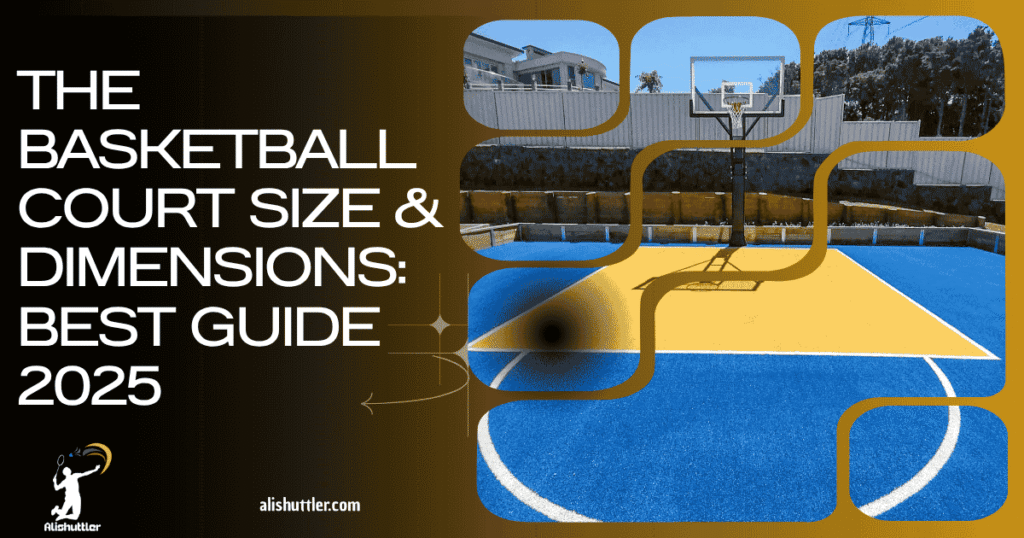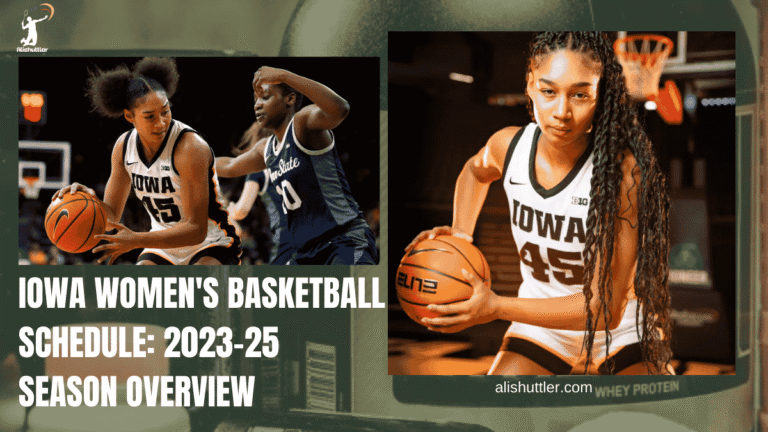A Standard Basketball Court is 28 meters long and 15 meters wide, with distinct markings for the key, free-throw, and three-point areas.
Materials vary from wood for indoor courts to concrete or asphalt for outdoor. Each court has a hoop on either end.
Understanding the arrangement allows players, coaches and fans to follow the action. The following sections have more information.

Court Anatomy
A basketball court, whether an indoor basketball court or an outdoor basketball court, consists of a flat, rectangular surface with baskets at either end. Each section of the court is delineated and dimensioned for an explicit reason, influencing the flow of the game and the strategies employed by the team.
The Layout
Let’s take a standard basketball court, 94ft by 50ft. It is divided in half, with a basket, free-throw circle, key and three-point arc on each side. The center circle sits right smack dab in the middle, used for the tip-off.
The key, or paint, measures 16 feet in width and extends 19 feet from the baseline to the foul line. The free-throw line is positioned 15 feet from the backboard. The three-point line is 23 feet 9 inches from the center of the basket at the top and 22 feet from the corners. For half court games, it is 47’ x 50’.
The restricted area under the basket creates a 4-foot radius arc in the NBA and 4.1 feet in FIBA. Solid, confident lines delineate each portion. These lines set limits, direct play, and keep scoring fair and simple to follow.
Painted lines assist refs in consistent calls and inform players where they are or need to be. A simple way to picture the court: a rectangle with curved arcs at each end, a bold rectangle under each basket, and a big circle in the middle. Every zone, every line, has a part to play.
Key Lines
Every single line on the court forms action. The free-throw line provides shooters a designated location for penalty shots. The three-point arc establishes the premium scoring area for deep shots.
The no charge zone, indicated by an arc around the basket, prevents defenders from establishing offensive fouls too close to the hoop. The low post, just outside the key, is a place for bang-in play and tough defense.
- Baseline: Marks the end boundaries behind each basket.
- Sideline: Runs the length of the court, marking the sides.
- Free-throw line: Where penalty shots are taken.
- Three-point arc: Marks the scoring line for long-range shots.
- Center circle: Used for the opening tip-off.
- Restricted area arc: Outlines the no-charge zone under the hoop.
Each with its defined task, assisting to maintain the flow, fairness and ease of play.
The Hoop
The hoop, positioned 10 feet (3.048 m) above the floor, is an essential component of any backyard basketball court. The rim, a ring of high-strength carbon steel measuring 18 inches across, is complemented by a backboard that is typically 1.8 meters wide and 1.05 meters tall. Constructed of clear glass or acrylic, this design enhances sightlines and bounce, making it perfect for both indoor basketball courts and outdoor settings.
The hoop stands 1.2 meters out from the baseline, supported by a solid post or wall mount. Baskets are the primary scoring objective, defining every shot attempt and defensive stand on the sport game court. The height and structure of the goal create a challenge for players of all levels.
Most hoops feature strong steel rims and a breakaway mount to absorb the power of dunks. For junior or recreational play, the hoop height may vary, frequently lowered for younger kids and increased with age and ability, ensuring a fun home experience for all.
Court Markings and Gameplay
Lines direct players on the sport game court, delineate boundaries, and assist officials. They keep play open and honest while shaping strategy and skill on the playing surface.
Court Varieties
Basketball courts vary in type, including residential basketball courts and outdoor basketball court options, each having their benefits and disadvantages. The form of flooring is a determinant in player performance, maintenance, and accessibility in various environments.
1. Hardwood Courts
Hardwood courts feature a smooth, polished wood finish and are most commonly seen in indoor, professional arenas. It boasts a pristine vintage-inspired surface and is crafted for high-performance.
Maple is the norm for these courts. Its close grain and strength provide a solid foundation that withstands rapid stops, leaps and directional changes. Provides top traction to help prevent slips and falls. Hardwood assists in cushioning impact, reducing injury risk for players.
Yet these courts require periodic cleaning and sealing to prevent dirt and moisture from creating havoc. If left in extreme heat or direct sun for too long, the wood will warp within a few months — so climate control is crucial.
2. Asphalt Courts
While asphalt courts — the kind you find at parks and schools — provide a nice community amenity, they’re rugged and outdoor durable, made for heavy traffic.
Asphalt is cheap and simple to lay, which makes it an excellent choice for common areas. These courts require little maintenance, though cracks can develop over time, particularly with frequent use or inclement weather.
Heat and rain can make the surface slick or even unsafe, so frequent inspections are a necessity. The game doesn’t feel the same on hardwood—less shock absorption means a harder impact on players’ joints, and the bounce of the ball can be less consistent.
3. Synthetic Courts
Synthetic courts utilize rubber, plastic or modular tiles to create a resilient, flexible surface. These floors work for all kinds of sports, not just basketball, in indoor gyms and outdoor complexes.
The key attraction of synthetic courts is their combination of toughness and low maintenance. They wear like iron and can be customized to suit a variety of demands, like increased traction or cushioning.
Modular tiles are popular because they’re easy to install and easy to replace if you damage one. Rubber can melt from heat, so outdoor rigs probably need to be shaded or cooled. Certain outdoor synthetic courts might require a complete resurface every couple years to maintain their quality.
4. Portable Courts
Portable courts are temporary and can be deployed briefly at schools, events, or community meets. These courts extend basketball’s popularity by simplifying the ability to put a game into play nearly anywhere.
Lightweight plastic or modular tiles are common, so setup and teardown is fast. Although they won’t provide the same sensation as fixed hardwood or asphalt, they permit safe play and fair ball bounce.
With the increasing popularity of portable courts, more people than ever before have the opportunity to experience basketball on a smaller scale with less expense or area required.
| Court Type | Main Material | Pros | Cons |
|---|---|---|---|
| Hardwood | Maple wood | Great traction, pro look, low injury risk | Needs upkeep, costly, can warp |
| Asphalt | Asphalt | Cheap, tough, easy to fix | Hard on joints, cracks, weather issues |
| Synthetic | Rubber/Plastic | Durable, easy care, made for many sports | Heat risk, might need resurfacing |
| Portable | Modular tiles | Flexible, mobile, fast setup | Less authentic, short-term use |
Design Evolution
Basketball courts have evolved quite a bit since the inception of the game, influenced by innovation and changing regulations. Today’s courts, whether an indoor basketball court or a backyard basketball court, reflect the increasing enthusiasm for the sport.
Early Courts
The early basketball courts, often referred to as sport game courts, seemed simple. They were mostly found on gym floors or even outdoors on dirt or wood surfaces. There was no established length or width; some courts measured only 74 feet long while others extended to 84 feet. Surfaces varied, with polished wood being popular, but many played on whatever materials they could find. There were no flashy designs or expensive logos at that time.
As basketball gained popularity, especially in schools and small clubs, these venues began to establish their own backyard basketball courts. These makeshift courts reflected the materials and cultural contexts of the era. Word of mouth and community gatherings helped the game grow, increasing both players and spectators.
By the mid-20th century, the demand for fair play and tournaments made that change. Courts became more standardized in dimensions and lines. This stage helped basketball ascend to new heights.
Rule Changes
Rule changes have influenced every aspect of court design. The introduction of the three-point line in 1979 is a prime example. Prior to that, the court had fewer markings. The new line altered the way players played offense or defense. Teams began to emphasize outside shots, and new player roles developed.
The distance to the three-point arc kept moving. NBA had it at 22 feet from 1994 to 1997. NCAA shifted its line for men and women to 20.75 feet in 2011. Each league implemented these changes in response to player and coach feedback. Markings such as the key and restricted area moved around with time. These adjustments sped up the game and opened it up.
Certain ancient courts, particularly in high schools, remain display previous designs. This is what makes the rules and court sizes constantly evolving to stay fresh.
Modern Aesthetics
Contemporary courts are synonymous with vibrant colors, dominant logos and distinct designs. Simply put, since the early 2000s teams and leagues use courts as a canvas to display their brand. Sponsors put their marks on the floor, mixing sports and commerce.
This emphasis on aesthetics is not merely for aesthetics’ sake. It creates anticipation for supporters and gives every stadium a unique atmosphere. World city courts wear local art or motifs. Creative designs allow venues to shine and the game to be more than a game.

Construction Insights
Planning and materials are the first steps in building a backyard basketball court. Every detail, from site prep to the finish, influences the court’s utility and durability. The choice of materials, weather conditions, and sustainability significantly affect how an outdoor basketball court looks, feels, and lasts.
Material Choice
Courts utilize wood, asphalt, concrete, or synthetic surfaces. All three materials offer different styles of play and maintenance requirements. Wood is typical for indoor courts, providing a slick bounce and less joint stress. Asphalt and concrete are outdoors, selected for durability.
Artificial turf can emulate wood or provide additional traction and cushioning. This stuff alters the bounce of the ball and it alters the safety of the court for the players. Wood and new age synthetics are easier on knees and ankles than asphalt. Concrete is durable, but can be rough on your body over extended games.
Maintenance counts. Wood floors require periodic cleaning and refinishing, whereas concrete and synthetic courts might just require surface inspections and resealing from time to time.
| Material | Use Location | Main Benefit | Maintenance Needs | Impact on Play |
|---|---|---|---|---|
| Wood | Indoor | Smooth bounce | High | Consistent, joint-safe |
| Asphalt | Outdoor | Cost-effective | Medium | Firm, less forgiving |
| Concrete | Outdoor | Very durable | Low | Hard, fast play |
| Synthetic | Both | Customizable | Low to Medium | Grippy, shock-absorb |
Climate Impact
Weather significantly impacts outdoor basketball courts, especially in terms of surface durability. Damp locations necessitate moisture-resistant surfaces to prevent warping and sliding on a residential basketball court. In hot or cold climates, these courts must manage expansion and shrinkage without cracking, ensuring a safe playing surface for athletes.
Proper drainage is essential for exterior courts. A gentle slope (1-2%) allows water to flow off, preventing puddles that can erode finishes and lead to slip-and-fall accidents. Weatherproof coatings and non-slip finishes are vital for maintaining safety on both outdoor basketball court options and indoor basketball courts.
Maintenance habits must adapt to the weather conditions. In rain zones, maintenance should include regular inspections for pooling water and moss growth. Conversely, hot, sunny climates could necessitate more frequent resurfacing to combat fading and cracks, ensuring the court remains functional throughout the season.
Sustainable Building
A lot of projects these days go green, grabbing the most earth-friendly resources and designs. Recycled rubber and plastic appear in certain contemporary court surfaces, reducing waste and emissions.
Sustainable courts assist not only the planet, but those who play on them. Good decisions here assist air quality and keep chemicals from the dirt. Community wellness gets a shot in the arm when courts are constructed with eco-friendliness in mind.
- Recycled materials keep waste out of landfills and reduce resource consumption. They can be transformed into wear surfaces that outlast new ones.
- It’s daylight-saving time, energy-efficient lighting lowers your power bills and slashes emissions, making those late-night games more planet-friendly.
Material Selection by Use
- Indoor courts commonly utilize wood due to its smooth texture and appearance.
- Outdoor courts prefer concrete or asphalt for all-weather durability.
- Synthetic surfaces do it for both, with additional shock absorption for safety.
- Select materials based on player age, skill, and court usage.
The Modern Court
The modern sport game court is more than just a play surface; it combines innovative technology, community, art, and diversity. Standard court features like the 3-point line and no charge zone highlight the foundational components that shape how we play the game and how these courts serve communities.
Smart Technology
Smart technology is a cornerstone of courts today. Sensors hidden beneath the maple floorboards of each court record player movement, shot precision, and ball speed. Digital boards show live stats. Others deploy cameras to disaggregate footwork, angles, and even heart rate, assisting competitors of any age track their improvements.
Tech tools transform the way coaches and players operate. Training apps sync with on-court sensors, allowing players to immediately check their shooting arcs or dribble counts. They can identify vulnerable areas or indications of weariness. This immediate feedback assists players repair habits quicker and learn more intelligently.
For fans, interactive scoreboards and instant replays from court cameras make watching more enjoyable. As courts integrate additional capabilities such as smart lights that respond to play speed or apps that direct individual drills the distinction between digital and physical gameplay begins to fade.
Community Hubs
Courts nowadays serve as meeting places of neighbors and friends. Kids rendezvous to play post school, adults convene for leagues and families stop by to spectate or root! The court is a place for us to bond, not battle.
Basketball gets people active. It enhances wellness, assists kids in expending energy, and unites people in a manner that gyms or clubs cannot. Others have programs that encourage locals to assist with maintaining courts, or organizing events, so everyone feels they are a part of it.
In many cities, schools and local groups have to share outdoor and indoor courts. These collaborations allow anyone from students to retirees easier access to find a place to play or join a team.
Artistic Expression
Art now influences the appearance and ambiance of courts. Big murals coat the face, merging lines of aggressive hue or local icons. Certain courts flaunt city landmarks and others adopt patterns drawn from indigenous traditions or street art.
Local artists are often commissioned to create these projects. Their work transforms a blank court into a destination people can’t wait to post and strike their best pose. These designs can make a neighborhood feel proud or designate a special occasion.
Innovative courts attract audiences, as well. More players and fans will show up if the court is distinctive.
Inclusivity in Court Design
The Modern Court thinks of everyone. They deploy ramps, paved routes and priority lines for the disabled. Some courts are color coded or have textured surfaces for players with impaired vision. Special programs welcome girls, beginners, and seniors to participate in coed matches or pick-up play.
Design modifications, such as lower baskets or a smaller court size, make play accessible for all ages and abilities. Groups work to hear what locals need before building.
Small steps help more people feel safe and welcome.
Global Standards
Global standards provide a uniform foundation for basketball courts around the world, ensuring the game remains just and consistent regardless of location. These are the standards that count when teams from around the world get together at international competitions. If courts were all shapes and sizes, it would alter player movement and game outcomes. One set of standards for indoor basketball court size and court markings keeps things fair for everyone.
Groups such as FIBA set the precedent. Under FIBA, for example, a standard court is 28 m x 15 m (about 91.9 x 49.2 feet). This size is standard in the majority of countries outside the USA and corresponds to what’s used in the UK. The full court spans 420 square meters, providing plenty of space for players to execute plays and defend, whether on an outdoor basketball court or an indoor facility.
Each line of the court – from the three-pointer to the sidelines – has a standardized width of 5 centimeters. The three-point line is located 6.6 to 6.75 m (21.65 to 22.15 ft.) from the basket in most international games. This contrasts with the NBA, where the three-point line is slightly further back, illustrating how FIBA seeks to maintain a flat playing field globally, regardless of whether it’s an outdoor basketball court option or a professional venue.
Consistent court markings are about more than just size. The free-throw line, for instance, is always 15 feet from the backboard’s plane, which makes foul shots all over. The no charge zone arc, which assists refs in ruling player contact under the basket, has a 1.22-meter (4-foot) radius in virtually every North American league above high school. Even these minor details count for how the game plays, especially in different settings like backyard basketball courts.
By adopting these global standards, leagues, schools and sports centers on multiple continents can ensure their courts are up to snuff. It keeps things on an even playing field, and both players and fans know the deal. It assists coaches prepare squads for global competitions, as court dimensions and markings won’t disrupt their strategy or their players’ muscle memory.
With identical rules, teams across the world can compete on an equal footing, making the game more egalitarian and transparent. Global standards assist basketball development. So when new teams, schools, or even countries construct match-sized courts to FIBA or other specifications, they ensure everyone can participate.

This allows more people, regardless of where they live, to play, watch and learn the game.
Final Thoughts
Basketball courts connect, in any size and any style. Wood floors glisten in huge arenas, and concrete courts sit in parks and on city blocks. Paint lines hold crisp and bright through fair play. Every spot has its own history, forged by games and ballers of all types. Courts keep evolving as regulations and requirements change in each nation.
Downtowns, towns, and universities all grow to these world standards. If you step on the court, you’re part of a great tradition, a long line of players and fans. To find out more or to tell us your courtside tale. Come on and join the conversation! All the voices, all the games count, right where you are.
Frequently Asked Questions
What are the main parts of a basketball court?
A basketball court, whether it’s an indoor basketball court or an outdoor basketball court, is composed of essential components like the playing area, sidelines, baselines, center circle, free-throw lines, and three-point arcs.
How big is a standard basketball court?
A typical pro basketball court is 28 meters by 15 meters. These measurements are established by global basketball governing bodies.
What types of surfaces are used for basketball courts?
Basketball courts, whether indoor or outdoor, are constructed of various surfaces like polished wood, concrete, or asphalt, impacting play speed and player safety.
How have basketball court designs changed over time?
Court designs for residential basketball courts have evolved, incorporating state-of-the-art surfaces that enhance player comfort and performance, ensuring safety and accessibility for all.
What is the difference between indoor and outdoor basketball courts?
Indoor basketball courts typically feature polished wood or synthetic surfaces crafted to maximize play and minimize injury, while outdoor basketball courts utilize concrete or asphalt engineered to endure weather and abuse.
Are there universal rules for basketball court markings?
Yes, with most markings being international standard, such as the free-throw line and FIBA arc, these regulations aid in making the play equitable on any sport game court.
Why do basketball courts have different varieties?
They come in varieties appropriate to the level of play, space, and local demand, including options like backyard basketball courts and indoor basketball courts, ranging from full-sized competition courts to smaller, recreational-based layouts.






